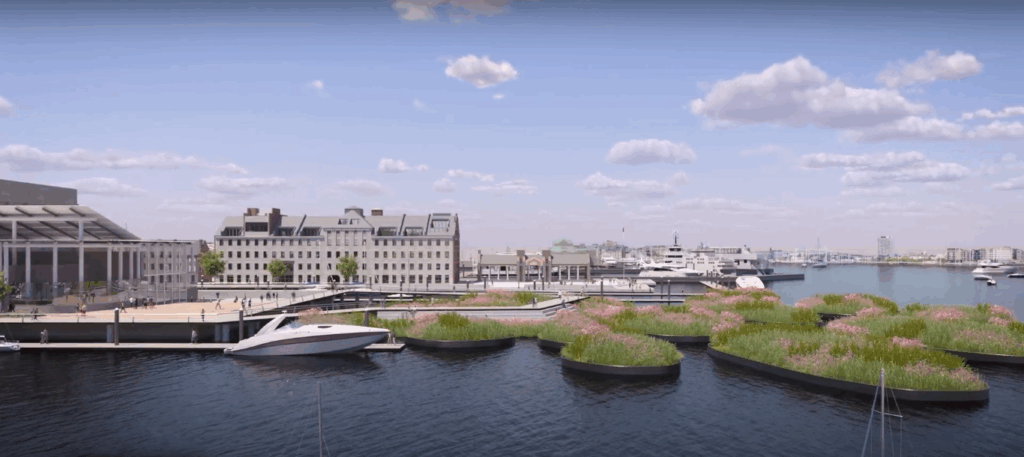
The Wharf District Council estimates it could cost up to $1.2 billion to fully protect downtown Boston from storm surges. iStock photo
It always comes down to the money.
Two years ago, the Wharf District Council group completed a comprehensive engineering study on what it will take to protect Boston’s downtown waterfront area from rising sea levels.
The climate resiliency recommendations for the 1.1 mile downtown coastal area – stretching from the Christopher Columbus Park to the north to Congress Street in the Fort Point area to the south – range from elevating portions of the Boston Harborwalk to installing new advanced stormwater systems.
Today, the nonprofit council, made up of key businesses, institutions and other parties with an interest in the future of the downtown district, is facing its most daunting challenge: coming up with the actual funds to pay for its recommended infrastructure protections against climate change.
“It’s going to be very expensive,” says Marc Margulies, president of the council and principal emeritus at Margulies Perruzzi, the Boston accounting firm.
A $1.2B Bill
How expensive? The council’s study estimates it could cost as much as $1.2 billion to fully protect the downtown coastal area, which reaches inland as far as the Old State House and includes large chunks of the Financial District.
The at-risk area includes Faneuil Hall Marketplace, Long Wharf, the New England Aquarium, the Harbor Towers condominiums, Boston Harbor Hotel and other landmarks.
But it’s not just prominent commercial and residential buildings at risk from rising seas and future potentially devastating storms. It’s also downtown roadways, docks and wharfs, and underground subway stations, utilities, sewer and water lines – even portions of the O’Neill Tunnel that carries Interstate 93.
In all, the study estimates a future catastrophic storm could cause as much as $4 billion in damage to an area of the city considered by many as critical to the entire New England economy.
“A big flood would be devastating to the district,” said Donald Chiofaro Jr., a member of the Wharf District Council and vice president of the Chiofaro Company, owner of International Place and the Harbor Garage, both located within the district. “It would be devastating to the entire region. To protect [the downtown district] is such as massive undertaking. It’s going to be a huge dollar cost.”

Living shorelines that buffer wave action are included in a proposed downtown Boston waterfront resiliency plan. Image courtesy of Wharf District Council
Hope to Spread the Financial Burden
Most agree it’s going to take a combination of private and public dollars to protect all of Boston’s 47 miles of coastline and the state’s 1,500 miles of coastline, including funds from property owners, the city and state.
But most also agree the federal government will have to chip in too – and probably chip in the vast bulk of the climate resiliency money needed.
“Anytime you have a major infrastructure [need] like this, it almost always requires a combination of local, state and federal dollars,” said state Sen. Nick Collins, whose legislative district includes the downtown wharf area and who attended a recent council meeting on its resiliency priorities.
As for state funding, Collins said Beacon Hill lawmakers plan to tackle many resiliency-related issues when reviewing Gov. Maura Healey’s proposed $2.9 billion environmental bond bill now on the legislative docket.
But Collins, like others, says so much of what needs to get done on the climate resiliency front depends on securing federal funds.
“It’s hard to know how it will turn out,” Collins said of federal funding for climate resiliency projects across the country. “I know we’re going to fight for every dime we can get.”
It’s especially hard to know what Congress might do considering today’s political climate in Washington.
Federal Help Appears Unlikely
The Trump administration and Republican-controlled Congress have shown little interest in tackling climate change issues in general, let alone climate resiliency programs – and that worries those who believe policy makers need to act fast to deal with rising sea levels.
No matter what politically happens in Washington, D.C., the local focus right now, officials say, needs to be on developing detailed resiliency plans and recommendations that can be forwarded to the U.S. Army Corps of Engineers, which is currently compiling a report on resiliency priorities across the region.
The Corps is expected to make its own climate resiliency recommendations to Congress by 2028, after which Congress will decide what will or won’t get funded, officials say.
“It’s a long process,” said Kate Dineen, president and CEO of A Better City, a nonprofit group representing 130 area businesses and institutions. The group is a member of the Wharf District Council.
“We did a lot of hard, thorough work to get our study finished,” said Dineen. “Now the biggest challenge is securing the funding. Right now, we’re focused on how to implement our plans.”
Ultimately, the Wharf District Council is hoping the city of Boston adopts many of its resiliency recommendations and forwards them to the Army Corps of Engineers.
But there’s no guarantee which portions of the study will get the green light from various government entities.
Margulies, president of the council, said his group is working closely with Mayor Michelle Wu’s office about the wharf district’s needs.
The council, which received about $750,000 in state funds to conduct its 2023 resiliency study, is also reaching out to other city neighborhoods about how they can launch their own climate resiliency studies.
“We’re urging other communities to get out front on this issue,” said Margulies. “We’re telling them there’s a role they can play [in resiliency preparations] and they need to accelerate the process.”





